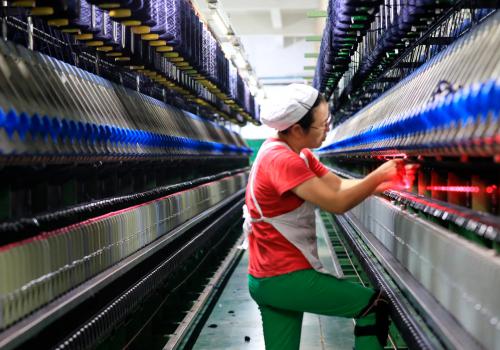China's diversified supply chain has helped the country regain trade growth in recent months, defying the coronavirus pandemic and economic tensions with the U.S. Chinese exports in September grew 9.9% on the year to $239.7 billion, the country's customs office said in a preliminary estimate Tuesday. Beijing's fourth monthly gain was backed by rising manufacturing activity and a recovery in external demand as more economies control the pandemic. Imports for September grew 13.2% to $202.7 billion after contracting in July and August. The rebound was aided by a lower base comparison and an increase in fixed-asset investment by manufacturers, which grew by 5% in August for the first gain this year. In the first nine months of the year, exports contracted 0.8% to $1.8 trillion, while imports declined 3.1% to $1.4 trillion.
China's official manufacturing purchasing managers index, an indication of factory activity, rose for the seventh straight month to reach 51.5 in September, sustained by growth in new orders and production. Beijing's top trade partner for the first nine months of the year was the Association of Southeast Asian Nations. Trade with the 10-member bloc totaled roughly $481 billion. Exports grew by 4.9% to $267 billion, while imports increased by 5.1% to $214 billion.Vietnam led ASEAN by absorbing 29% of China's exports and contributing nearly one-quarter of China's imports from Southeast Asia. Meanwhile, exports to the U.S., which account for 20% of the total, rose 21% to $44 billion, up for the fourth straight month. By product category during the same period, China's exports were broadly driven by textiles, which grew 33%, followed by medical equipment and electrical devices, including personal computers. Imports were led by machinery and food, including meat and cereals. Semiconductors also contributed to the rise despite a ban imposed on Sept. 15 by Washington against Chinese tech giant Huawei Technologies. The ban restricts shipments of tech components and software that originate from the U.S. Chinese companies appear to have increased purchases of these items ahead of the ban. UBS Global Research credits Beijing's recent gains to the lower base in 2019, caused by the U.S. trade war, and the shift by Chinese companies toward Taiwan and Vietnam in response.
"China's capacity and flexibility in tech production and restructuring of supply chains have likely helped," said a September report by UBS economists in Hong Kong. China's exports to Taiwan have remained resilient since 2017 despite political tensions and the pandemic, the report noted, driven by shipments of tech components and growing supplies of components sent to the island for further processing. The growth also reflects the interdependence of both economies despite growing political tension. While some Taiwanese tech producers have moved production in the mainland back to Taiwan to avoid U.S. punitive tariff on Made-in-China products, they could be relying on the component supplies from the mainland. Mainland exports to Taiwan rose 8.1% to $37 billion during the first eight months of 2020, while imports grew 10.6% to $121 billion. During the same period, Taiwan's exports to the U.S. increased by 7%, led by electronic products.
Beijing's strong exports of electronics to Vietnam also may reflect the supply chain shift in part, as China supplies more components to producers that have moved to Vietnam or expanded there, the report said. Chinese companies that have expanded to Vietnam include Guoguang Electric, which announced a $10 million effort in 2018 to mitigate "volatile business investment as a result of the trade war." The audio equipment maker exports about one-fifth of its products to the U.S. Yu Kaho, an analyst at risk adviser Verisk Maplecroft in Singapore, said China's export growth will slow in the coming months once households abroad finish shopping for work-from-home items. Yu added that domestic consumption remains weak due to poor government support, which was directed mainly into infrastructure projects. Export growth remains uncertain, while imports will depend on the sustainability of China's recovery and its trade relations with the U.S. "The external outlook remains challenging as many important trading partners are facing the risk of another wave of COVID-19 resurgence during winter, which will dampen the speed of their economic recovery and their demand for Chinese exports," Oxford Economics of the U.K. wrote in a report on Tuesday.
